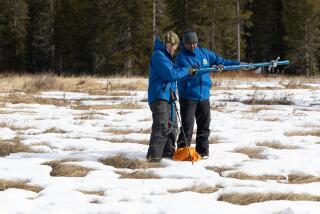Warming may spur forest growth
SEATTLE â While gradually warming global temperatures long have been seen as an environmental threat, a study released Monday suggested that the forests of the Pacific Northwest could see a substantial gain in productivity as the thermometer climbs.
The bulk of the gains from climate change will be seen at higher elevations -- above 3,000 feet -- and in forests east of the Cascade Mountains, according to researchers at Oregon State University. Lower-elevation forests, where most of the commercial timber is harvested, could see reduced growth as a result of drier conditions.
The study, published in the journal Forest Ecology and Management, is one of the first to look at a variety of climate change models and predict what might happen to the signature forests that are an economic and ecological mainstay of the West as the climate warms.
Already, researchers have found detrimental effects from pest and disease infestation as a result of warmer temperatures that have begun killing off trees such as aspens, white bark pines and Douglas fir.
But a warmer climate also could have a positive effect if, for example, more tree growth reduced the amount of carbon in the air, said Greg Latta, the lead researcher on the study.
âCertainly, if youâre putting more cubic meters of wood on an acre each year, thatâs more carbon out of the atmosphere. Thatâs a good thing,â he said.
On the other hand, he said, the addition of more biomass in the forests could mean more fuel for fires.
Researchers didnât take into account the potential effects of fire or pests, which do not tend to die off as readily with warmer temperatures, he said.
The study -- conducted along with the U.S. Forest Service -- found that potential effects would be greatest in Washington, where high-elevation forests could see growth increase from 35% a year to as much as 500%, depending on the climate scenario.
Oregonâs high-level forests might see gains of 9% to 75%.
Even with expected declines of 1% to 3% a year in forest productivity at lower elevations, overall productivity could increase about 7% a year in forests west of the Cascades and 20% to the east, the study found.
âThereâs a lot of variability here, depending on which climate scenario turns out to be most accurate and what policy changes are made as a result,â Darius Adams, professor of forest economics at Oregon State, said in a statement.
âClearly the forest growth is likely to increase the most at higher elevations, but itâs worth noting that those forests never had very high growth rates to start with.â
--






